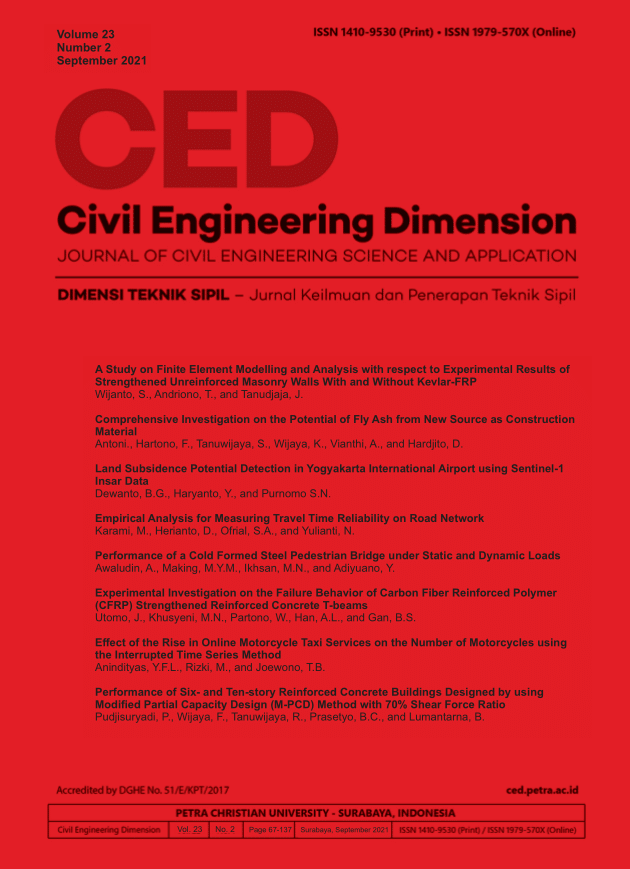Performance of Six- and Ten-story Reinforced Concrete Buildings Designed by using Modified Partial Capacity Design (M-PCD) Method with 70% Shear Force Ratio
DOI:
https://doi.org/10.9744/ced.23.2.131-137Keywords:
Modified partial capacity design, partial side sway mechanism, reinforced concrete, seismic designAbstract
One design alternative of earthquake resistant building is Partial Capacity Design (PCD) method. Unlike the commonly used capacity design method, PCD allows a safe failure mechanism which is called partial sidesway mechanism. In this mechanism, all beams and some columns are allowed to experience plastic damages while some selected columns are designed to remain elastic (called elastic columns). A new approach to predict the required strengths needed to design each structural member, called modified-PCD (M-PCD) is proposed. In this research six- and ten-story reinforced concrete buildings were designed using M-PCD, and their seismic performances are investigated. The base shear force resisted by the elastic columns was set to approximately 70% of the total base shear. Both nonlinear static procedure (NSP) and nonlinear dynamic procedure (NDP) are used to analyze the structures. The results show that the expected partial side sway mechanism is observed, and the drifts of the buildings are acceptable.
References
Badan Standarisasi Nasional, SNI-03-1726-2012. Tata Cara Perencanaan Ketahanan Gempa untuk Struktur Bangunan Gedung dan Non Gedung, Jakarta, 2012.
Paulay, T. and Priestly, M.J.N., Seismic Design of Reinforced Concrete and Masonry Buildings, John Wiley & Sons, Inc., New York, 1992.
Lumantarna, B., (1994), Perencanaan Kapasitas Alternatif, Suatu Studi Pendahuluan, Proceedings of the Conference on Modern Design and Construc¬tion for Safety, Economy, and Durability, Petra Christian University, Surabaya, Indonesia, 1994.
Muljati, I. and Lumantarna, B., Partial Capacity Design, an Alternative to the Capacity Design Method, Proceedings of the 19th Austra¬lasian Conference on the Mechanics of Structures and Materials, ACMSM19, Christchurch, New Zealand, 2007, pp. 409-414.
Muljati, I. and Lumantarna, B., Performance of Partial Capacity Design on Fully Ductile Moment Resisting Frame in Highly Seismic Area in Indonesia, The Eleventh East Asia-Pacific Con-ference on Structural Engineering and Con¬struc¬-tion (EASEC-11), Taipei, November, 2008.
Tanaya, L.S., Metode Modified Partial Capacity Design (M-PCD), (Unpublished Thesis), Universi-tas Kristen Petra, Surabaya, Indonesia, 2021.
Federal Emergency Management Agency 273, NEHRP Guidelines for the Seismic Reha¬bilitation of Buildings, Washington, D.C., USA, 1997.
CSI Analysis Reference Manual for SAP2000, ETABS, SAFE and CSIBridge, Computer & Structure, Inc., 2017.
Badan Standarisasi Nasional, SNI-03-2847-2013, Persyaratan Beton Struktural untuk Bangunan Gedung, Jakarta, 2013.
Downloads
Published
How to Cite
Issue
Section
License
Authors who publish with this journal agree to the following terms:- Authors retain the copyright and publishing right, and grant the journal right of first publication with the work simultaneously licensed under a Creative Commons Attribution License that allows others to share the work with an acknowledgement of the work's authorship and initial publication in this journal.
- Authors are able to enter into separate, additional contractual arrangements for the non-exclusive distribution of the journal's published version of the work (e.g., post it to an institutional repository or publish it in a book), with an acknowledgement of its initial publication in this journal.
- Authors are permitted and encouraged to post their work online (e.g., in institutional repositories or on their website) followingthe publication of the article, as it can lead to productive exchanges, as well as earlier and greater citation of published work (See The Effect of Open Access).











